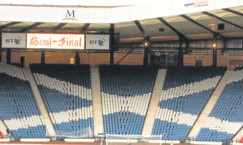
This season’s Scottish Cup Final between Inverness Caley Thistle and Falkirk provides a great opportunity for Scottish football to return to some form of tradition.
In years gone by, the Hampden showpiece always attracted a proportion of neutral fans, especially when neither Celtic nor Rangers were involved. Sadly, this habit has died out.
Neither of this season’s finalists will put the SFA under pressure for extra tickets, so it’s a wonderful chance for the neutrals to turn out in numbers.
The SFA has certainly done its bit by persuading both the Highlanders and the Bairns to accept ticket prices ranging from just £5 to £30. For once, no-one can accuse the authorities of trying to milk the occasion dry.
Now it’s up to traditionalists, if there are any left, to turn back the clock.
The first Final I attended was all of 51 years ago, when Rangers defeated Dundee 3-1. In fairness, there were very few neutrals in the 120,982 who bought tickets for that rainy afternoon. But there were more than a few in 1952 when Motherwell and Dundee clashed in front of an astonishing 136,304.
And the last time Falkirk got their hands on the trophy in 1957, a combined crowd of 160,842 saw them defeat Kilmarnock after a replay. Plenty of that huge turn-out went along to see the Final, not particularly caring who came out on top.
95,123 saw Clyde beat Hibs the following year and 108,591 watched St Mirren overcome Aberdeen in 1959. Sadly, crowds in general have dipped since those halcyon days.
The lowest Cup Final crowd since the war was 30,602 for Rangers v Hibs in 1979. It was the third attempt to find a winner and clearly the fans had had enough.
Inverness Caley Thistle and Falkirk are unlikely to bring 30,000 between them at the end of this month. So the May 30 showpiece really needs the neutrals if the crowd isn’t to be an all-time low.
It’s already been dubbed the ‘Family Final’, as these occasions usually are.
To reach its true meaning relies on supporters of other clubs turning out in numbers.
It’s a far cry from 1937 when 147,365 paid on the day, with an estimated 30,000 locked out of the Celtic-Aberdeen Final. That crowd remains a European record for a club encounter.

Enjoy the convenience of having The Sunday Post delivered as a digital ePaper straight to your smartphone, tablet or computer.
Subscribe for only £5.49 a month and enjoy all the benefits of the printed paper as a digital replica.
Subscribe